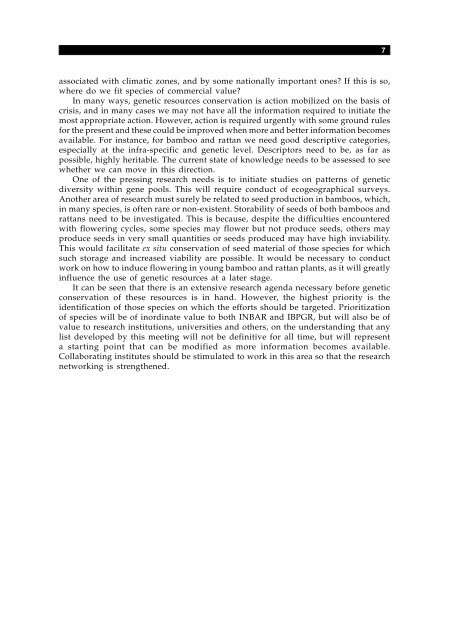Priority species of bamboo and rattan - Bioversity International
Priority species of bamboo and rattan - Bioversity International
Priority species of bamboo and rattan - Bioversity International
You also want an ePaper? Increase the reach of your titles
YUMPU automatically turns print PDFs into web optimized ePapers that Google loves.
associated with climatic zones, <strong>and</strong> by some nationally important ones? If this is so,<br />
where do we fit <strong>species</strong> <strong>of</strong> commercial value?<br />
In many ways, genetic resources conservation is action mobilized on the basis <strong>of</strong><br />
crisis, <strong>and</strong> in many cases we may not have all the information required to initiate the<br />
most appropriate action. However, action is required urgently with some ground rules<br />
for the present <strong>and</strong> these could be improved when more <strong>and</strong> better information becomes<br />
available. For instance, for <strong>bamboo</strong> <strong>and</strong> <strong>rattan</strong> we need good descriptive categories,<br />
especially at the infra-specific <strong>and</strong> genetic level. Descriptors need to be, as far as<br />
possible, highly heritable. The current state <strong>of</strong> knowledge needs to be assessed to see<br />
whether we can move in this direction.<br />
One <strong>of</strong> the pressing research needs is to initiate studies on patterns <strong>of</strong> genetic<br />
diversity within gene pools. This will require conduct <strong>of</strong> ecogeographical surveys.<br />
Another area <strong>of</strong> research must surely be related to seed production in <strong>bamboo</strong>s, which,<br />
in many <strong>species</strong>, is <strong>of</strong>ten rare or non-existent. Storability <strong>of</strong> seeds <strong>of</strong> both <strong>bamboo</strong>s <strong>and</strong><br />
<strong>rattan</strong>s need to be investigated. This is because, despite the difficulties encountered<br />
with flowering cycles, some <strong>species</strong> may flower but not produce seeds, others may<br />
produce seeds in very small quantities or seeds produced may have high inviability.<br />
This would facilitate ex situ conservation <strong>of</strong> seed material <strong>of</strong> those <strong>species</strong> for which<br />
such storage <strong>and</strong> increased viability are possible. It would be necessary to conduct<br />
work on how to induce flowering in young <strong>bamboo</strong> <strong>and</strong> <strong>rattan</strong> plants, as it will greatly<br />
influence the use <strong>of</strong> genetic resources at a later stage.<br />
It can be seen that there is an extensive research agenda necessary before genetic<br />
conservation <strong>of</strong> these resources is in h<strong>and</strong>. However, the highest priority is the<br />
identification <strong>of</strong> those <strong>species</strong> on which the efforts should be targeted. Prioritization<br />
<strong>of</strong> <strong>species</strong> will be <strong>of</strong> inordinate value to both INBAR <strong>and</strong> IBPGR, but will also be <strong>of</strong><br />
value to research institutions, universities <strong>and</strong> others, on the underst<strong>and</strong>ing that any<br />
list developed by this meeting will not be definitive for all time, but will represent<br />
a starting point that can be modified as more information becomes available.<br />
Collaborating institutes should be stimulated to work in this area so that the research<br />
networking is strengthened.<br />
7

















